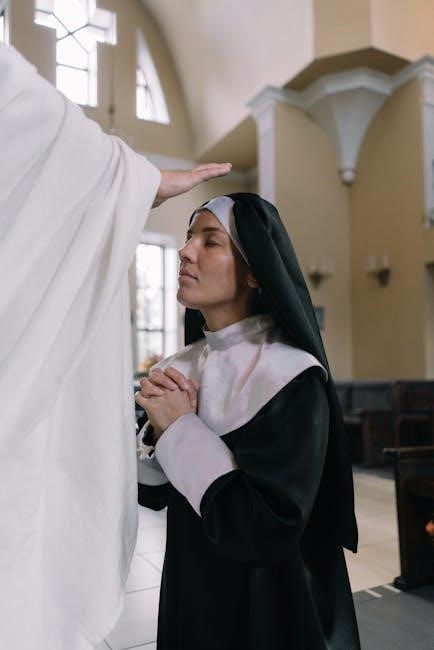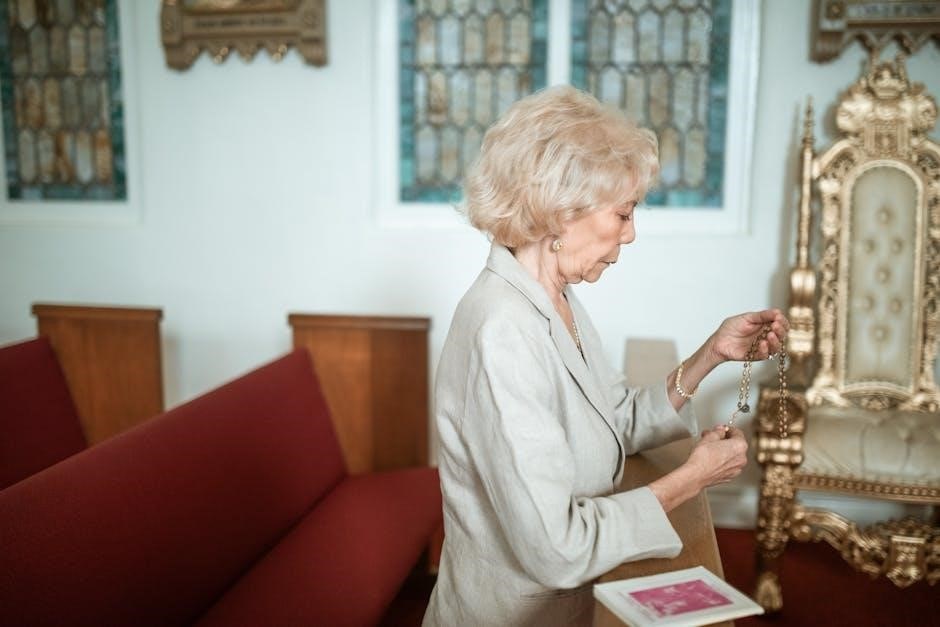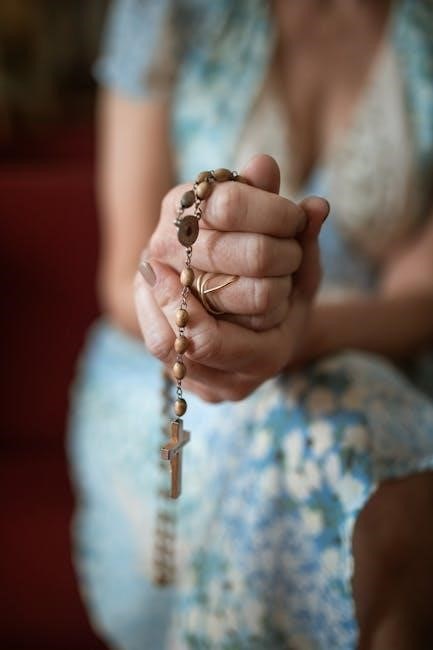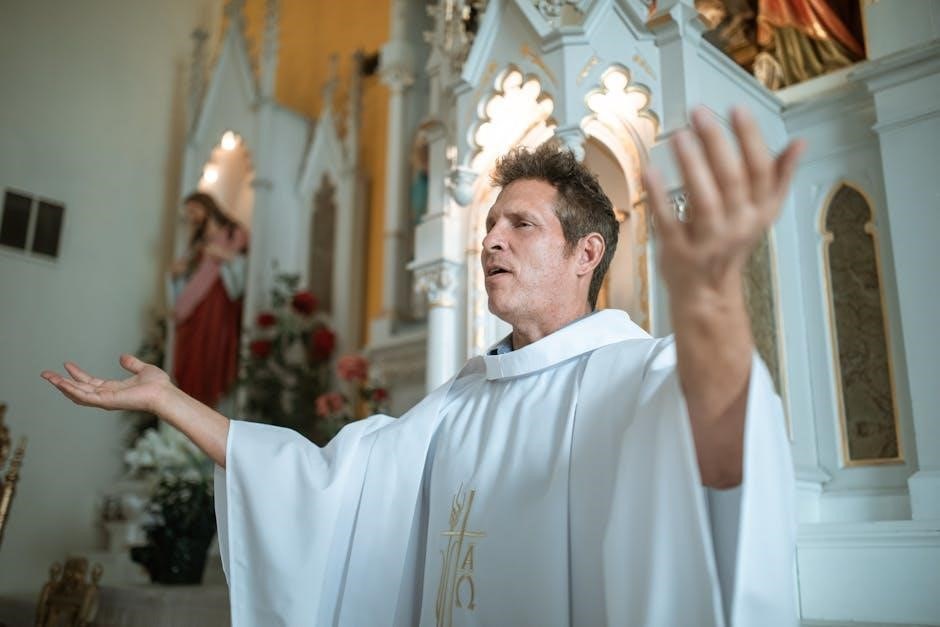catholic prayer for house blessing and protection pdf
Catholic house blessing is a tradition that brings faith and family together, using prayer and holy water to sanctify the home, providing a sense of peace and protection for all who live there always.
Setting for the Blessing
The setting for the Catholic house blessing is a crucial aspect of the tradition, as it sets the tone for the entire ceremony. To begin, gather as a family in a room of your choice, such as the living room, with a few essential items, including a blessed crucifix or icon, holy water, and if possible, blessed salt. These items can be obtained from your local parish office or Narthex. It is also a good idea to have a crucifix blessed by a priest if you do not already have one. The room should be tidy and free from distractions, allowing all participants to focus on the blessing. A peaceful and serene atmosphere can be created by playing soft music or lighting candles. The leader of the blessing should be prepared to guide the family through the ceremony, which may involve reciting prayers and sprinkling holy water throughout the home. By setting the scene in this way, the family can come together to ask for God’s protection and blessing on their home. The setting for the blessing is an opportunity for the family to slow down and reflect on their faith and their relationship with God.

The Prayer of Blessing
The prayer of blessing is spoken by the leader, asking God to be their shelter and companion, using words of faith and devotion always.
Reciting the Lord’s Prayer
Reciting the Lord’s Prayer is an essential part of the Catholic house blessing ceremony, where all participants gather together to pray, using the traditional words of the prayer to invoke God’s presence and protection.
The Lord’s Prayer is a well-known prayer that is recited by Catholics around the world, and its inclusion in the house blessing ceremony serves to unite the participants in their faith and to seek God’s guidance and protection.
The prayer is typically recited after the leader has spoken the prayer of blessing, and it is a moment of quiet reflection and devotion, where participants can express their gratitude and ask for God’s blessing on their home and family.
The recitation of the Lord’s Prayer is a powerful way to consecrate the home and to invite God’s presence into the lives of those who live there, and it is an important part of the Catholic tradition of house blessing.
The prayer is a beautiful expression of faith and devotion, and its recitation is a meaningful way to mark the occasion of a house blessing, and to seek God’s protection and guidance for the future.
The Lord’s Prayer is a prayer that is familiar to Catholics of all ages, and its recitation is a comforting and reassuring experience that can bring a sense of peace and tranquility to those who participate.

Conducting the Blessing

The leader guides the ceremony, using prayer and holy water to bless the home, providing a sense of peace and protection for all who live there always with faith.
Leader’s Role
The leader plays a crucial role in conducting the house blessing ceremony, guiding the family and guests through the prayers and rituals. The leader is responsible for setting the tone and creating a sacred atmosphere, using holy water and prayer to sanctify the home. They must be familiar with the ceremony and able to lead the group with confidence and conviction. The leader’s role is not only to lead the prayers but also to explain the significance and meaning of the ceremony, helping to create a deeper understanding and appreciation of the tradition. By taking on this role, the leader helps to bring the family and community together, fostering a sense of unity and faith. The leader’s participation is essential to the success of the ceremony, and their commitment to the tradition helps to keep it alive. The ceremony is a beautiful way to express gratitude and ask for protection, and the leader’s role is vital in making it a meaningful and memorable experience.
Prayer for Protection
A prayer for protection is an essential part of the house blessing ceremony, asking for God’s safeguard against evil and harm. The prayer is typically recited by the leader, with the family and guests joining in, and is often accompanied by the sprinkling of holy water. The prayer for protection is a way of seeking God’s guidance and care, asking for his watchful eye to be over the home and its occupants. It is a beautiful expression of faith and trust, acknowledging God’s power and love. The prayer can be recited in a variety of ways, but its core message remains the same: to ask for God’s protection and blessing. By including a prayer for protection in the house blessing ceremony, families can feel a sense of peace and security, knowing that they are under God’s care. The prayer is a powerful way to invoke God’s presence and to seek his help in times of need, and is an important part of the Catholic tradition. The ceremony is a meaningful way to express devotion and to ask for God’s protection and guidance.

of the Blessing
The conclusion of the blessing is a final expression of gratitude and praise, thanking God for his presence and blessing in the home. The ceremony typically ends with a final prayer or song, and the family and guests may gather to share a meal or refreshments together. This is a time for celebration and fellowship, marking the beginning of a new chapter in the home’s history. The conclusion of the blessing is also a reminder that the home is a sacred space, a place where faith and family come together. By ending the ceremony on a note of gratitude and praise, families can cultivate a sense of joy and appreciation for the blessing they have received. The conclusion of the blessing is a beautiful way to bring the ceremony to a close, leaving a lasting impression on all who participated. It is a meaningful way to express devotion and to ask for God’s continued presence and blessing in the home. The ceremony is a special way to mark the beginning of a new chapter in the home’s history, and the conclusion of the blessing is a fitting end to this meaningful ritual.
